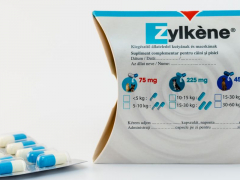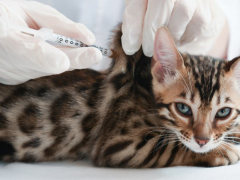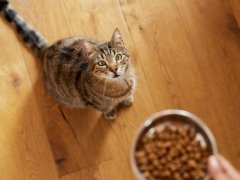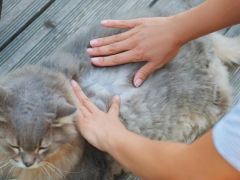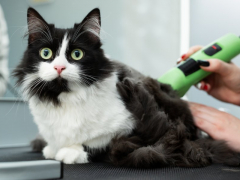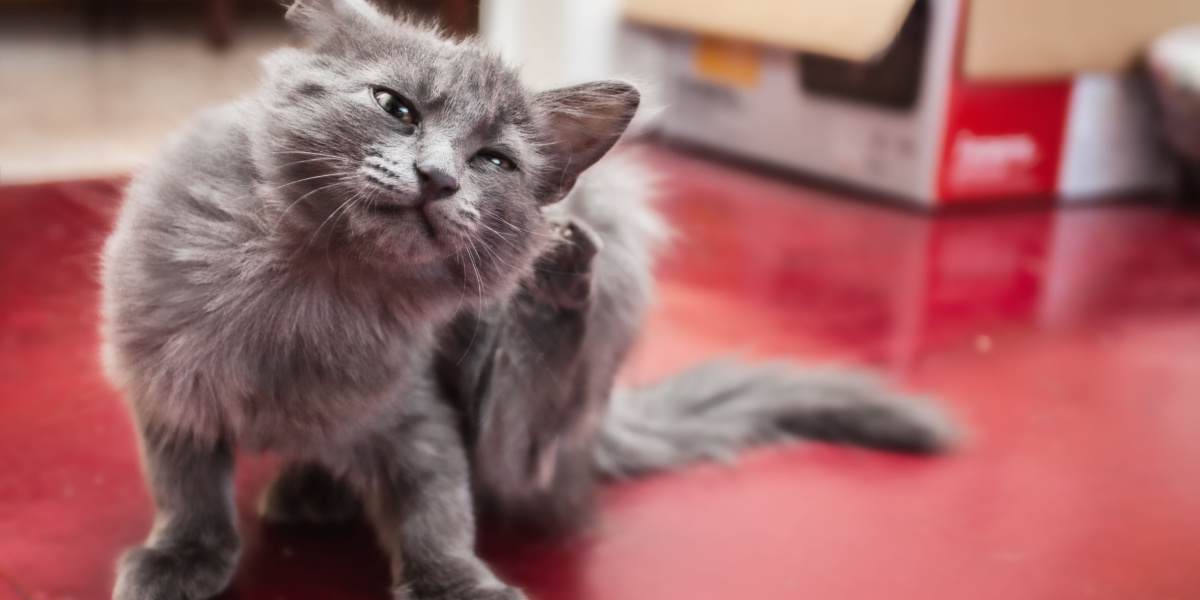
Bravecto topical solution for cats is a brand of topical flea and tick preventative product developed by Merck Animal Health. In this article you’ll learn what Bravecto for cats is, how it works, potential side effects, appropriate dosing, and some frequently asked questions.
Bravecto For Cats Overview

About Bravecto for Cats
Bravecto is the brand name for the drug fluralaner, a member of the isoxazoline class of antiparasitics. In the US, it is labeled only for killing and preventing flea infestations and two species of ticks, the black-legged or deer tick (Ixodes scapularis), and the American dog tick (Dermacentor variabilis).
In Europe, it does carry a label for killing and preventing fleas as well as the Ixodes ricinus tick.
Bravecto has also been used in an off-label manner to treat cats with ear mites (Otodectes cynotis) and skin conditions caused by infestations from the skin mites Demodex gatoi and Demodex cati.
It has also been found to be effective against a Caribbean fur mite Lynxacarus radovsky, and the Australian paralysis tick Ixodes holocyclus.
Regular Bravecto for cats does not have activity against intestinal parasites or mosquito-borne heartworms in cats. However, the Bravecto Plus for Cats product does.
Although Bravecto is a topically-applied product, the drug is absorbed systemically, the same as the oral products used for dogs.
What Does Bravecto Do for Cats?
The active ingredient in Bravecto topical solution for cats, fluralaner, kills fleas and ticks by blocking a primary inhibitory neurotransmitter called GABA.
By inhibiting an inhibitory neurotransmitter, fluralaner causes overstimulation and uncontrolled nerve activity in the insects targeted, leading to death.
According to the manufacturer, Bravecto has been shown to effectively kill 100% of adult fleas within 8 hours of application, and nearly 100% of black-legged ticks by 48 hours after application. It continues to work and be effective for up to 12 weeks in those cases, but it has only been found to have efficacy against the American dog tick for 8 weeks.
The manufacturer does recommend that if American dog tick infestations are a primary concern, that the product can be safely used every 8 weeks for that purpose.
Side Effects of Bravecto for Cats
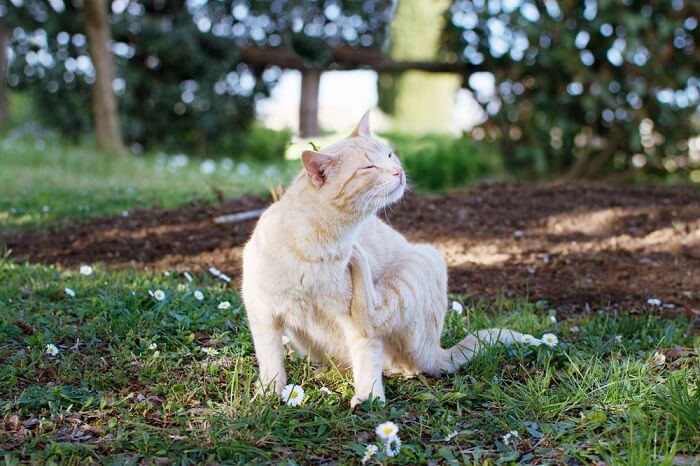
FDA has advised that Bravecto should be avoided or used very cautiously in cats with a history of seizures or another neurologic disease.
When used properly, side effects to Bravecto for cats appear to be uncommon. Bravecto for cats is labeled only for cats over 6 months of age. Topical products like Bravecto for cats should never be ingested. Safety has not been evaluated for pregnant or lactating cats.
According to the manufacturer, side effects of Bravecto for cats are very uncommon but vomiting, diarrhea, and itching were most often reported. In a controlled field study evaluating the safety of Bravecto that involved about 220 cats, just under 8% of treated cats showed signs of vomiting. About 5% of cats exhibited diarrhea, itching, and hair loss at the application site. Other signs like lethargy and decreased appetite were seen in less than 4% of cats.
While considered uncommon, the Food and Drug Administration (FDA) has advised that drugs in the isoxazoline class have the potential for causing neurologic adverse effects including muscle tremors, difficulty with balance and walking (ataxia), and seizures. This has been seen even in pets without a prior history of neurologic disease. Bravecto should be avoided or used very cautiously in cats with a history of seizures or another neurologic disease.
In the field study, seizures were not seen, but ataxia was noted in two cats, who recovered completely. No further signs were seen after the reapplication of the product.
In both dogs and cats who are given the topical product orally, most exhibited signs of hypersalivation (drooling) but few additional adverse effects were seen.
This does raise an important point, as topical products like Bravecto for cats are often very bitter tasting.
If a kitty were to lick recently applied Bravecto off either themselves or a housemate, the bitter taste alone can lead to excessive drooling, agitation, and sometimes even vomiting.
According to DVM360’s article “Toxicology Brief: The 10 most common toxicoses in cats” this effect is typically not a true toxicity, but a sometimes dramatic reaction to the bitter taste. Providing milk or liquid from a tuna can help resolve the signs in short order.
To avoid this from happening, it is important to apply any topical flea/tick product to the skin in front of the shoulder blades at the back of the neck, a location even the most flexible cat cannot reach to lick. In multiple cat households where lots of co-grooming occurs, separating housemate kitties for up to 24 hours after application to allow the product to fully dry may be advisable.
Although Bravecto products for dogs and cats contain the same active ingredients, there are slight differences in the percentages of active ingredients and inactive ingredients. Any oral and topical dog products should never be used for cats.
If you have any concerns for potential toxicity, even if you think your kitty might have just licked some Bravecto off her fur and is having a bitter taste reaction, always be sure to contact ASPCA Animal Poison Control (1-888-426-4435) or the Pet Poison Helpline (1-855-764-7661). A fee does apply, but your vet will often need the toxicologist’s advice to help develop a treatment plan for your cat.
Bravecto for cats is not known to interact with any other medications. However, you should consult with your veterinarian if you are considering combining Bravecto with any other topical flea/tick products.
Lastly, Bravecto for cats was rarely found to cause facial dermatitis in people a couple of days after application on their cats in the European field study.
It is best to avoid contact with any flea/tick preventative solution during application and to wash your hands after. Make sure the solution is dry on your cat before touching the application site, and make sure to keep it out of reach of children.
Bravecto for Cats Dosage
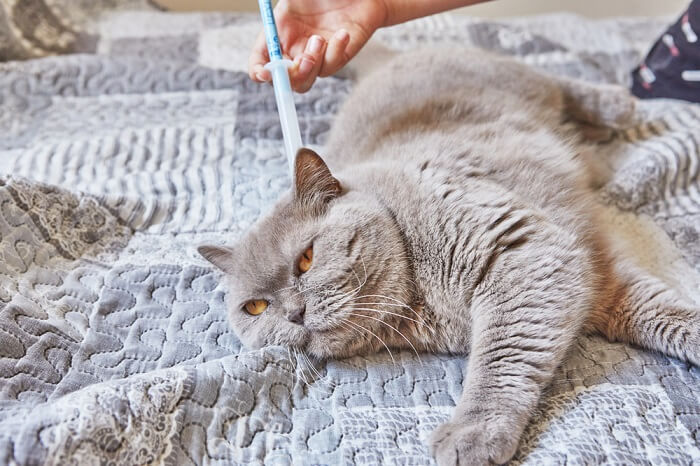
The manufacturer recommends not bathing a kitty for at least 3 days after application of Bravecto. Bathing shortly before application may also reduce its effectiveness.
There are three doses available for Bravecto for cats, which are based on a cat’s body weight. Always make sure to apply the proper dose for your cat’s weight.
How Long Does Bravecto Last for Cat
Bravecto for cats is typically applied every 12 weeks. If there is significant concern about American dog tick infestation, the manufacturer recommends using it every 8 weeks.
How to Apply Bravecto Plus for Cats
Always follow all instructions on the packaging for any topical product you use for your kitty. Bravecto tubes first need to be removed from their pouch packaging. The cap should then be rotated clockwise or counterclockwise for one full turn.
The cap is intended to remain on for application and should not be removed. The contents of the tube can then be applied to a cat’s skin by parting the fur and applying to the skin along the back of the neck in front of the shoulders at the base of the skull where a kitty cannot reach to lick it off.
The manufacturer recommends not bathing a kitty for at least 3 days after application of Bravecto. Bathing shortly before application may also reduce its effectiveness.
If for some reason you are unsure if the product was administered correctly or whether all of it was applied, it is usually safest to not apply an additional dose.
If you have any questions about the application or safety for Bravecto for cats or any topical product, make sure to get in touch with your veterinarian.
Is Bravecto Safe for Cats?

leas like an environmental temperature of 21 – 29’C (70 – 84’F). Fleas are around 3-4mm (1/4 to 1/3 inch)
Bravecto for Cats is considered an effective and safe option for most cats for killing fleas and ticks and preventing infestations. While it has a more limited range of effect compared to some other topical products, the need to only apply it every 2-3 months may be more appealing for some kitty parents.
Drug Dosing Disclaimer: We are only able to provide doses for medications that are FDA approved for use in cats and only as the label guidelines dictate. For medications that are used off-label we can only provide guidelines and safety information for use. Safe and appropriate dosing for off-label medications can only be determined by a primary care veterinarian.
We encourage you to work with your veterinarian to determine if a particular medication is appropriate for your cat. Changing or adjusting a dose for your cat on your own without consulting with a veterinarian can carry risk. We do not encourage use of medications prescribed for human use in pets without first consulting with a primary care veterinarian.
Frequently Asked Questions
Is Bravecto Bad for Cats?
Fluralaner has not been found to have a higher or more concerning degree of side effects in cats compared to other flea/tick products in field trials.
Fluralaner is considered very selective for insect neurons over mammalian neurons in the way that it works. While uncommon neurologic side effects have been reported with this drug class, these were not seen widely in the field studies and likely occur only in a very small single digit percentage of otherwise healthy cats. It should be avoided however in any cat with a prior history of neurologic abnormalities like seizures.
In terms of other side effects seen in the field studies like vomiting, diarrhea, and itching, it is important to note that side effect percentages were very similar to the control group which did not receive any doses of the drug at all.
Do You Need a Prescription for Bravecto for Cats?
Yes. While Bravecto for cats is a topical solution, it is absorbed systemically by the body. Any topical solution absorbed this way (Revolution is another one for example) are regulated by the FDA and do require a prescription just like oral medications do.
How Long Does Bravecto Last in Cats?
When targeting fleas and the black-legged tick, Bravecto is effective for 12 weeks. It has only been found to be effective for 8 weeks for the American dog tick. In an area where the American dog tick is a major concern or infestations are likely, the manufacturer recommends using it every 8 weeks instead. You can ask your veterinarian what is most appropriate based on your region and your cat's activity.
What Happens if a Cat Licks Bravecto?
In field studies, nearly all cats administered topical Bravecto for cats by mouth exhibited signs of hypersalivation (drooling). A couple exhibited limited coughing, and one cat vomited a couple times about 2 hours after application. No other significant side effects were seen. Most topical flea/tick preventatives have a very bitter taste, and the drooling is often secondary to this.
As stated earlier in the article, follow the application instructions closely, applying the product at the back of the neck in front of the shoulder blades where a kitty is unable to reach that area to lick. Housemate cats and dogs should be separated after application of the product until it is dry.
In any situations where licking or ingestion of the product is suspected, make sure to contact your veterinarian, ASPCA Animal Poison Control (1-888-426-4435) or the Pet Poison Helpline (1-855-764-7661). A fee does apply, but your vet will often need the toxicologist's advice to help develop a treatment plan for your cat.
Is bravecto safe for pregnant cats?
Safety has not been evaluated for pregnant or lactating cats.
